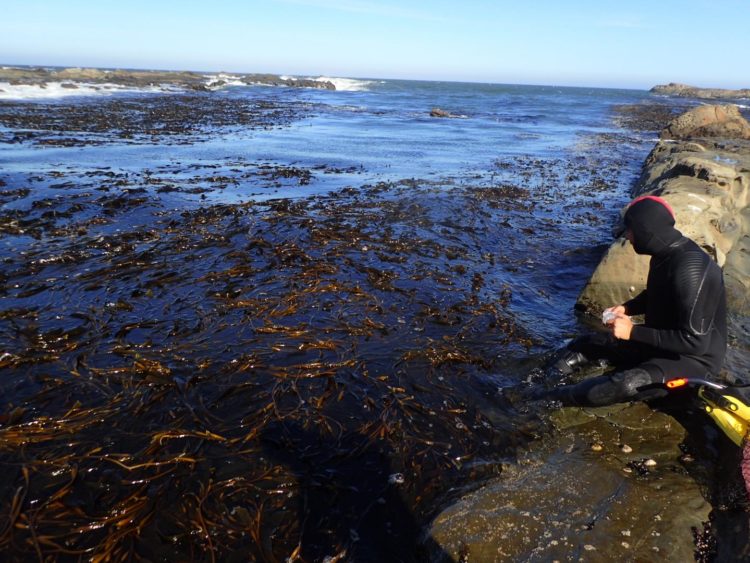In a changing ocean, giant kelp’s reproductive success depends on where it’s from

Credit: Jordan Hollarsmith/UC Davis
When a marine heat wave hit California’s coast in 2014, it brought ocean temperatures that were high for Northern California but fairly normal for a Southern California summer. Much of the giant kelp in the north died in the heat wave, while southern populations survived.
Jordan Hollarsmith was a National Science Foundation graduate research fellow at the UC Davis Bodega Marine Laboratory at the time. She wondered why the same species would respond so differently to similar conditions, and what that might mean for the future of giant kelp under climate change.
Hollarsmith’s study, published in the Journal of Experimental Marine Biology and Ecology, examines how giant kelp may respond to increased ocean warming and acidification. The authors investigated the reproductive success of giant kelp populations in Northern California, Southern California and Chile by exposing them in a laboratory to a range of temperatures and pH levels.
TESTING THE WATERS
Like someone from Minnesota being dropped into an Arizona heat wave, giant kelp living in cooler, high-latitude waters were more vulnerable to excessive heat than kelp already living in warmer, Southern California waters. The high-latitude kelp completely failed to reproduce when stressed by the heat.
That result carries implications for giant kelp restoration projects, as well as the future of the species as major marine heat waves become more common with climate change.
“Just because giant kelp grows in Baja doesn’t mean populations in Northern California or Alaska will be resistant to these heat wave events,” said Hollarsmith, currently a postdoctoral fellow at Simon Fraser University. “They are the same species, but each population might be distinct, which has consequences for how giant kelp will respond to changes in climate and upwelling patterns.”
KELP FOUNDATIONAL TO OCEAN LIFE
From chilly Alaska to the warm waters of Mexico, giant kelp forests grow amid a variety of temperatures. But both bull kelp and giant kelp are being threatened by marine heat waves and other climate change stressors.
Giant kelp forests are foundational to ocean ecology and biodiversity, providing food, habitat and shelter for many fish, marine mammals and other sea life. The iconic plants that can shoot more than 100 feet from the ocean floor are nearly synonymous with sea otters, who wrap themselves in giant kelp to keep from floating away as they sleep.
SOUTHERN CALIFORNIA KELP MORE RESILIENT
For the study, the researchers focused on giant kelp at its tiniest early life stages, when it is invisible to the human eye and thought to be most sensitive to environmental changes.
Kelp from each of the three regions were exposed to low and high ranges of temperature — from 50 F to 68 F:
Kelp from Chile and Northern California, which experience very similar climates, were both vulnerable to high temperatures, experiencing almost complete reproductive failure at the higher range of the experiments.
Southern California populations were much less vulnerable to high temperatures and successfully completed their life cycles.
OCEAN ACIDIFICATION DIDN’T HURT REPRODUCTION
For the ocean acidification side of the experiment, the researchers were surprised to find that reproduction was not hurt by low pH, or high acidity. In fact, populations that regularly experience low pH through upwelling or internal waves had greater reproductive success when exposed to greater acidity.
The researchers were not sure why the kelp responded this way. Perhaps more carbon dioxide made it easier for kelp to photosynthesize. Plants also sometimes flower when under stress as a last-ditch attempt to reproduce. Further research is needed to confirm those theories.
“This study gave me some hope,” Hollarsmith said. “The fact that ocean acidification was not negatively affecting them, and that some populations still completed their life cycles in warm, 68-degree temperatures, shows that at least some populations are quite resistant. That knowledge can help move us forward.”
###
Study co-authors include Edwin Grosholz from the UC Davis Department of Environmental Science and Policy, and Alejandro H. Buschmann and Carolina Camus from the University of Los Lagos in Chile.
The research was supported by the National Science Foundation’s Graduate Research Opportunities Worldwide fellowship and the CONICYT-Chile Fund for Exploration, the Point Reyes National Marine Sanctuary Neubacher Fund, and the UC Davis Henry A. Jastro Research Fellowship.
Media Contact
Kat Kerlin
[email protected]
530-752-7704
Original Source
https:/
Related Journal Article
http://dx.





